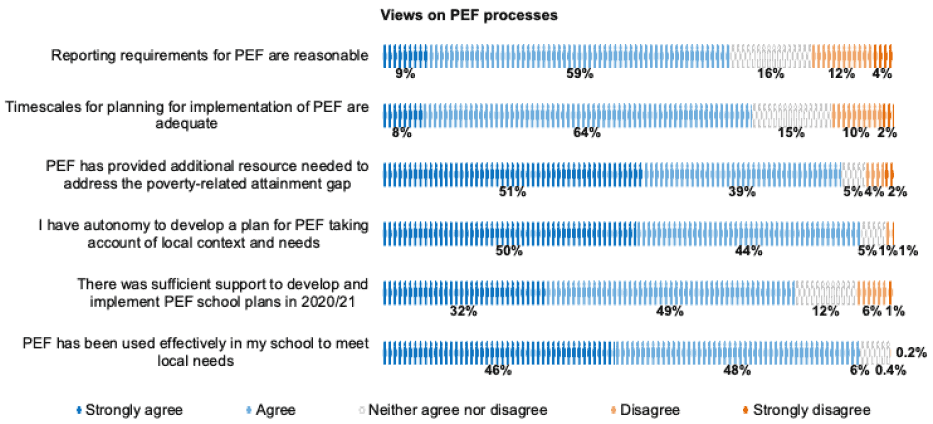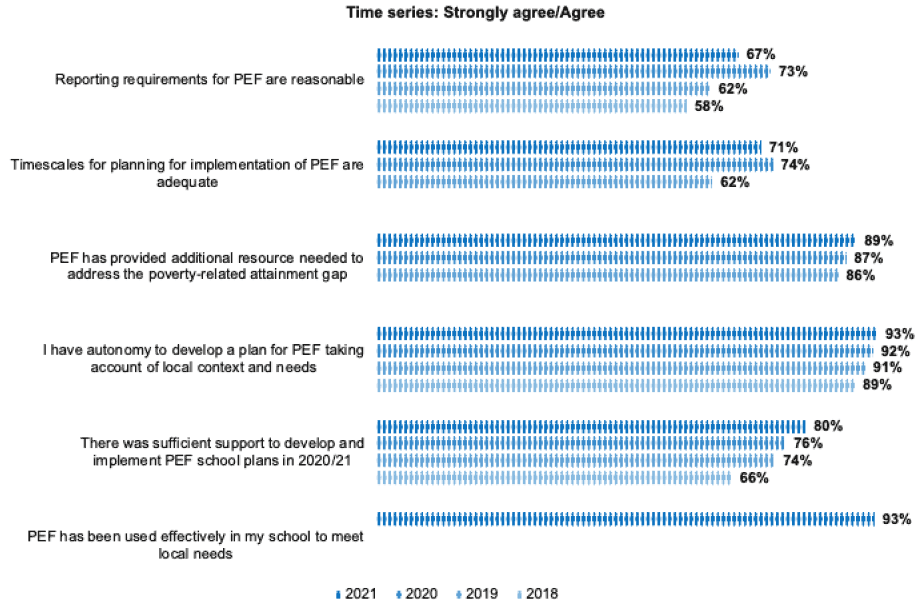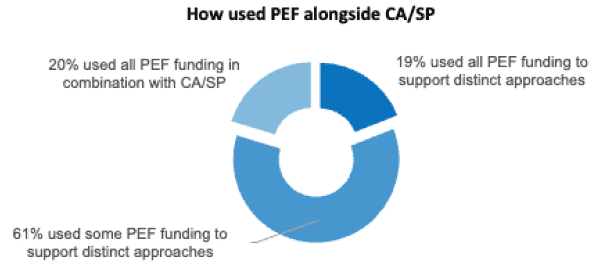Attainment Scotland Fund evaluation - Headteacher Survey: 2021 report
This report presents key findings from the sixth survey of headteachers of schools in receipt of Attainment Scotland Fund (ASF) support, covering the 2020 to 2021 academic year including the period of school building closures from January to March 2021.
6. Pupil Equity Funding
6.1. This section summarises schools’ experience around application for and receipt of PEF. This includes views on processes around the development of schools’ approach, and the specific impact of PEF-supported approaches.
PEF processes and developing schools’ approach
6.2. Survey respondents were generally positive in relation to PEF processes. Most (67%) felt that reporting requirements associated with PEF were reasonable, and a similar proportion felt that timescales for planning for PEF have been sufficient (71%). These findings were broadly similar to previous surveys.
6.3. The great majority of headteachers also felt that there was sufficient support to develop and implement PEF school plans (80% indicated this) and that they had autonomy to develop plans that are responsive to their local context and needs (93%). These views were again similar to the 2020 and 2019 survey, although the proportion who feel they had autonomy to develop their plans has increased by 12 percentage points since the 2017 survey.[9] Views were also consistent across key respondent groups.
6.4. Views were also highly positive on whether PEF had provided additional resource needed to address the poverty-related attainment gap (89% felt this has been the case), and that PEF had been used effectively to meet their school’s needs (93%). Views on whether PEF has provided additional resource have remained consistent over previous surveys.

6.5. Most respondents indicated that they had drawn on multiple resources in developing plans for PEF. The most commonly used were teachers within the school (used by 91%), local guidance published by local authorities (90%), parents and communities (78%), children and young people (74%) and local authorities (72%).
6.6. This profile is broadly similar to that reported in the previous survey. There has been a 13-point fall in the proportion of schools referring to Education Scotland, although this has fluctuated from year to year over previous surveys. Similarly, a 10-point fall in the proportion referring to parents and communities as an information source is from a peak in the 2020 survey (currently findings are similar to the 2019 survey).
6.7. Survey results also show some variation across key respondent groups. The most significant are noted below.
- Challenge Authority schools, those in urban areas and those with higher PEF allocations were more likely than others to consult with parents and communities.
- Secondary schools and those with higher PEF allocations were more likely to consult Education Endowment Foundation resources.

Perceived impact of PEF
6.8. This year’s survey included several new questions which sought to further improve understanding of the specific impact of the Pupil Equity Fund, in addition to the impact of ASF support as a whole. These questions were only asked of those in receipt of PEF funding and Challenge Authority or Schools Programme support, and focused on how PEF has been used alongside other ASF support, and the perceived impact of PEF in closing the poverty-related attainment gap.
6.9. Most survey respondents in receipt of PEF funding and CA/SP support indicated that they used at least some of their PEF funding to support approaches that were distinct from CA/SP approaches; 80% indicated this, including 19% who used all of their PEF funding to support distinct approaches. This finding was similar across key respondent groups.

Note: Only asked of schools in receipt of PEF and CA/SP
6.10. Headteachers who had used their PEF allocation to fund distinct approaches indicated that these were typically focused on providing additional wellbeing support. This included initiatives to tackle poverty, and joint approaches with third sector organisations focused in mental health needs. A substantial number also indicated that their PEF allocation had been used to support distinct attainment-focused initiatives, including some with a specific focus on literacy attainment and supporting pupils with dyslexia. Others had used PEF to support wider pedagogy developments and improved teaching and learning, or to provide additional staffing capacity.
6.11. The survey also asked schools in receipt of PEF funding alongside Challenge Authority or Schools Programme support for their views on any improvement in closing the poverty-related gap specifically as a result of their use of PEF. This was in addition to their views on the overall impact of ASF in closing the poverty-related attainment gap, as reported at Figure 17.
6.12. The great majority (94%) of those in receipt of PEF and CA/SP support reported seeing an improvement specifically as a result of their PEF funding. This included 20% who had seen ‘a lot’ of improvement to date as a result of their PEF funding.

Note: Only asked of schools in receipt of PEF and CA/SP
6.13. The above findings suggest that headteachers in receipt of PEF and CA/SP support were more positive about the impact of PEF funding specifically, than about the impact of ASF support as a whole. For example, the 94% of those in receipt of PEF and CA/SP who had seen improvement specifically as a result of PEF compares with the 87% of all respondents who have seen improvement as a result of ASF support.[10]
Contact
Email: socialresearch@gov.scot
There is a problem
Thanks for your feedback